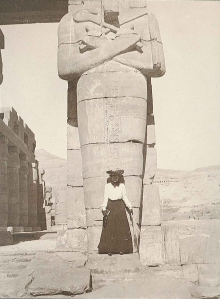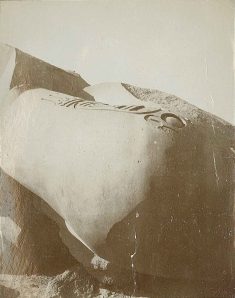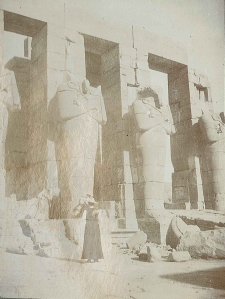The Real Rameses the Great
Speaking of Rameses the Great, no ancient figure had a greater impact on during Marjorie’s trip than the pharaoh Rameses II, perhaps the greatest king ever to rule Egypt. Towards the end of her trip she visited his mummy, on display at the Egyptian Museum in Cairo. She shares her thoughts:
It seems almost wicked that he should have descended to a “shilling show” from being such a wonderful ruler – but perhaps he does not mind for he was proud of his greatness, and after all it is with homage in their hearts that all these people come from every land to see him. You may feel mere curiosity before you see him, but once in front of that wooden coffin, looking down on the mummy of perhaps the greatest king that ever lived, you are bound to be awed, to respect and even admire. His strength, his bravery, his ability, his power of will – are all written in the emaciated face before you. Perhaps, yes undoubtedly, his father Seti has a more intellectual, a gentler, more cultured face – but with Rameses lies the courage, the undaunted energy and the pride of the greater ruler. His hands were wonderful to see – long well shaped, and full of power. And as he lies there now, this man who died at nearly a hundred years of age 3 thousand, five hundred years ago, he measures over six feet.
Rameses II ruled for an astonishing 66 years from 1279 to 1213 BC, during Egypt’s New Kingdom. He is probably best known for his military conquests. During his reign he greatly expanded the borders of Egypt, south into Nubia (modern day Sudan) and east into Canaan, (modern day Syria, Lebanon, and Israel) Egypt became one of the mightiest empires the world had ever known. One of Rameses II’s greatest achievements was his “victory” at the Battle of Kadesh, the largest chariot battle ever. There he fought the Hittites, an empire to the north centered in modern day Turkey. The battle began with a surprise attack by the Hittites and an initial retreat by the Egyptians, however Rameses’ quick action prevented a total rout. Most historians believe that while the Egyptians may have narrowly won the battle—or at least brought it to a stalemate—they lost in the long run as they failed to maintain control over the area. Despite this Rameses returned home a hero. The battle is also notable as it resulted in what may have been history’s first peace treaty—or at least the oldest written record of one—the Ramses-Hattusili Treaty.
It must have been humbling for Marjorie to see such power and grandeur reduced to a decrepit mummy, especially considering that Rameses is equally well known for building numerous monuments to his honor. Marjorie saw many of these throughout her journey. At Luxor:
On the pylon was Rameses II (the Great) in his chariot fighting single handed against the Hittites and a long poem beneath described the event . . .The best thing at Luxor was a statue of Rameses the Great, standing – his huge hand grasping a scroll. It was absolutely unblemished thro’ all these years.
And at Ramesseum, a temple built in Rameses’ honor, she took several photos.
The wonderful old ruin of Rameses II with its massive pillars its Osirus statues, and the gigantic figure of Rameses overthrown by an earth quake and weighing 2,000,000 lbs!




